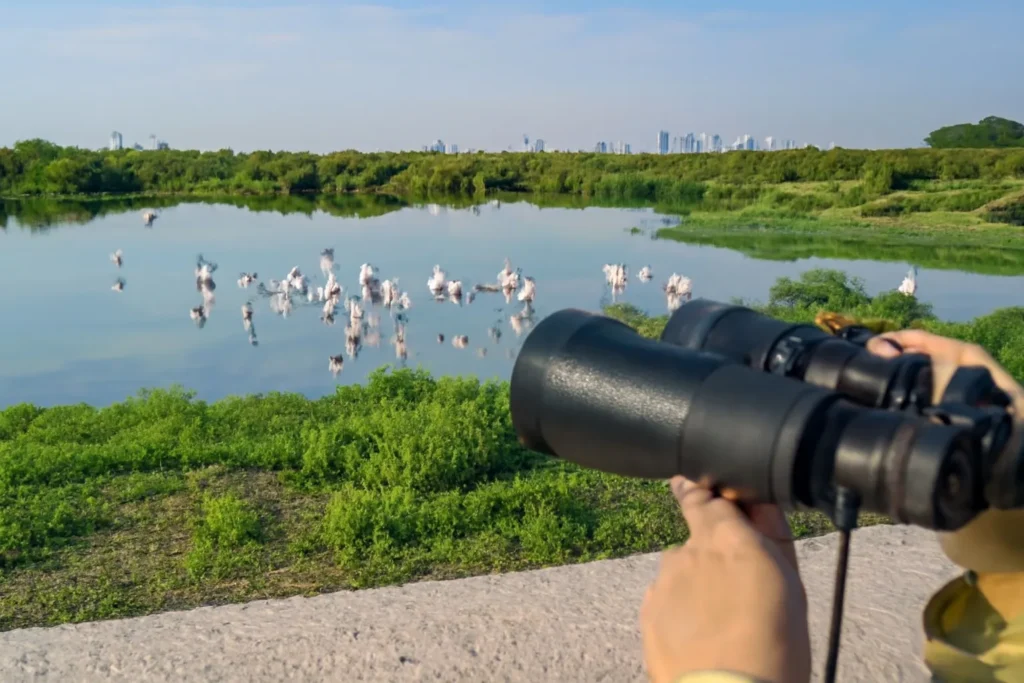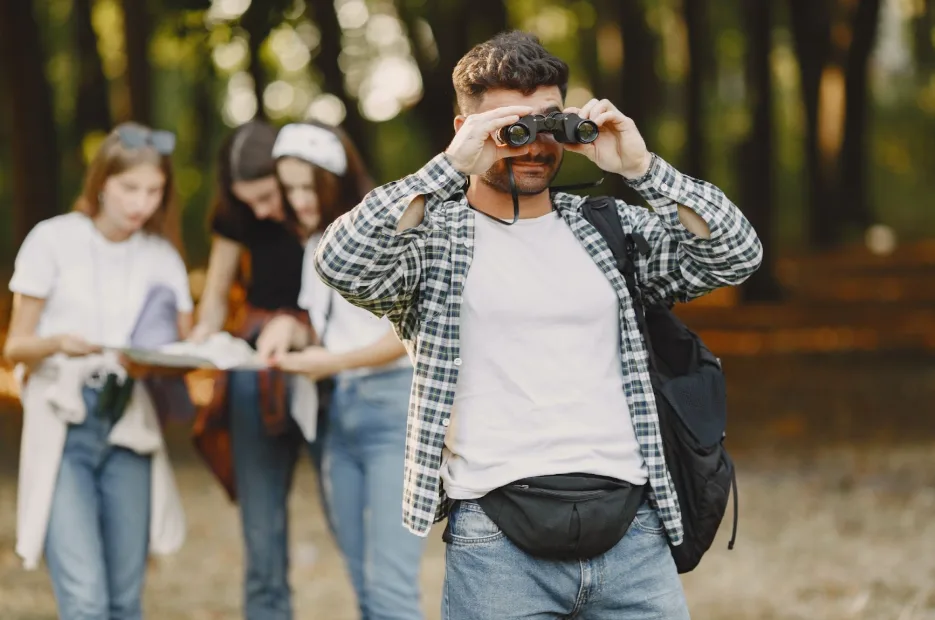
Birdwatching Hotspots Around Abu Dhabi
- Blog
-
Aug 15
- Share post

Have you ever stood quietly by the water and watched a bird land just a few meters away?
Abu Dhabi is one of the UAE’s most rewarding destinations for birdwatching, thanks to its unique mix of landscapes, from coastal lagoons and mangrove forests to man-made wetlands and offshore islands. These diverse habitats attract hundreds of bird species, including seasonal visitors that arrive during long migrations across continents.
The city’s efforts to protect and restore natural areas mean that many birdwatching locations are easy to access and well-maintained. Whether you’re a dedicated birder or simply enjoy spotting wildlife, these sites offer a chance to see everything from flamingos to rare waders in their natural surroundings.
Why Abu Dhabi is Great for Birdwatching
Abu Dhabi lies along one of the key migratory routes for birds traveling between Europe, Asia, and Africa. The emirate’s mild winter climate and rich feeding grounds make it an important stopover and wintering location. Coastal wetlands, mangroves, salt flats, and inland oases all provide safe spaces for birds to rest, feed, and breed.
In total, more than 400 species have been recorded in the UAE, and Abu Dhabi’s protected areas host a large share of them. Birdwatching here is not just about ticking species off a list; it’s about experiencing the rich variety of life that thrives between the desert and the sea.
1. Eastern Mangrove Lagoon National Park
One of the easiest spots to reach from the city, the Eastern Mangrove Lagoon National Park is a mix of calm waterways and dense mangrove trees. These mangroves, mainly Avicennia marina (grey mangroves), offer a safe haven for fish, crabs, and, of course, birds.
You can often spot western reef herons, great egrets, and collared kingfishers here. Migratory waders such as sandpipers and plovers visit in large numbers during winter. The best way to explore is by kayak, allowing you to move quietly and get closer to the birds without disturbing them.
Early mornings provide softer light for photography, while late afternoons can be cooler and equally rewarding. Even a short paddle through the mangroves can reveal dozens of species within minutes.
2. Al Wathba Wetland Reserve
Al Wathba Wetland Reserve is perhaps Abu Dhabi’s most famous birdwatching site. Located around 40 kilometers from the city, this reserve covers both natural and man-made habitats, including freshwater and saline lakes, reed beds, and open mudflats.
It’s most famous for its flamingo population. In winter, thousands of greater flamingos gather here to feed, creating a spectacular sight of pink and white stretching across the water. Other notable species include black-winged stilts, Kentish plovers, little grebes, and marsh harriers.
The reserve has well-marked walking trails and shaded viewing platforms, making it comfortable for visitors. Binoculars are helpful, but many birds can be seen clearly with the naked eye. Late winter and early spring are peak times for bird activity here. So, add it to your list of best things to do in Abu Dhabi.
3. Jubail Mangrove Park
Jubail Mangrove Park offers a unique way to observe birds without getting wet. Its elevated boardwalk winds through a natural mangrove forest, giving visitors a chance to see both resident and migratory species from above the water.
Kingfishers, such as the pied kingfisher and collared kingfisher, are common here, often seen hovering or diving for fish. Herons and egrets patrol the shallow water, while ospreys may be spotted overhead. Because the boardwalk runs through a tidal area, bird activity changes with the tides. Visiting at high tide often brings more birds closer to the walkway.
This site is family-friendly and provides educational signs about the ecosystem, making it a good choice for both birdwatchers and casual visitors.
4. Saadiyat Island
Saadiyat Island is better known for its beaches and luxury resorts, but its natural coastal areas also attract an impressive variety of birds. The sandy shores and shallow lagoons provide feeding grounds for species such as Kentish plovers, sanderlings, and oystercatchers.
During migration periods, the dunes and scrub areas behind the beaches can host passerines and other land birds stopping to rest. Because parts of the island remain undeveloped, there are quiet stretches where birds feed undisturbed. Early morning is the best time to avoid beachgoers and see more wildlife activity.
5. Sir Bani Yas Island
Sir Bani Yas Island is a true wildlife sanctuary. Managed as a nature reserve, it is home to not only exotic animals like gazelles and Arabian oryx, but also to a wide range of bird species.
The island’s wetlands attract flamingos, cormorants, and a variety of wading birds. Offshore, you may spot terns, gulls, and even ospreys nesting. Guided nature drives and walks often include birdwatching as part of the experience, and the quiet, protected environment means birds are less shy here.

Visiting requires a ferry or a stay at one of the island’s resorts, making it more of a full-day or overnight trip, but the variety of wildlife makes it worth the effort. So, make sure you add it to the list of things to do in Abu Dhabi with family.
6. Western Mangrove National Park
Less visited than the Eastern Mangroves, the Western Mangrove National Park offers a more remote birdwatching experience. Here, the mangrove channels are wider and less disturbed, making them a refuge for species that prefer quiet conditions.
Common sightings include grey herons, Eurasian curlews, and whimbrels. Because access is usually by guided kayak or small boat, you can reach areas that are otherwise hidden from view. This site is ideal for birdwatchers who want a peaceful setting and are comfortable spending more time on the water.
7. Yas Marina and Yas Links Golf Course
Yas Island may be known for Formula 1 races and theme parks, but its quieter corners provide surprising birdwatching opportunities. The Yas Marina area and the lagoons around Yas Links Golf Course attract waders, gulls, and waterfowl.
The open grass and water edges also draw birds of prey like kestrels and, during migration, the occasional osprey. Because these areas are not traditional reserves, birdwatching here can be combined with other leisure activities on Yas Island.
Additional Birdwatching Tips
Best Time of Year
October to April is the prime birdwatching season in Abu Dhabi. This period coincides with cooler weather and the arrival of many migratory species.
Best Time of Day
Early morning and late afternoon are ideal, as birds are more active and lighting is better for photography.
Gear
Binoculars are essential for distant species. A camera with a zoom lens can capture closer details. Always wear light, breathable clothing and bring water.
Respect Wildlife
Keep a reasonable distance from birds, especially nesting sites. Avoid loud noises and sudden movements, and stay on designated paths in reserves.
Conclusion
Abu Dhabi’s birdwatching hotspots showcase the emirate’s natural diversity and its role as a key stopover for migratory birds. From the pink sweep of flamingos at Al Wathba Wetland Reserve to the quiet elegance of herons in the mangroves, every site offers its own charm.
Whether you visit a boardwalk in Jubail, kayak through the Eastern Mangroves, or venture out to Sir Bani Yas Island, you’ll find that birdwatching here is both relaxing and rewarding.
For a more guided experience, GuideUAE can arrange tailored birdwatching tours with local experts who know the best spots, times, and species to look for.